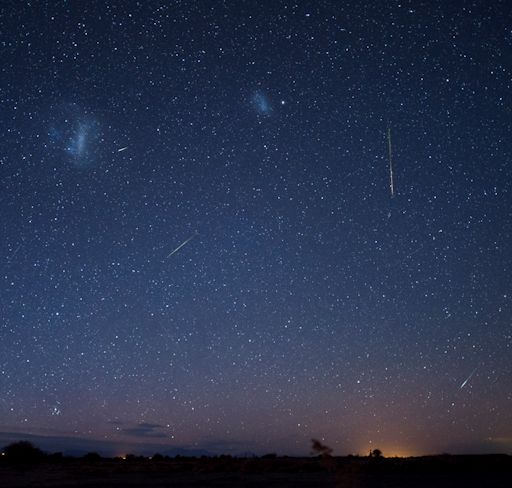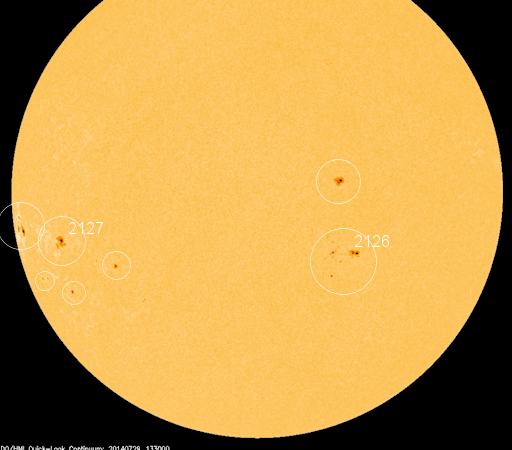New from Spaceweather.com: Edge of Space Advertising. Send your product or message to the edge of space for a down-to-Earth fee. Profits support student space weather research. Email Dr. Tony Phillips for more information. | | | COUNTDOWN TO THE ROSETTA COMET: The European Space Agency's Rosetta spacecraft is now less than 2000 km from Comet 67P/Churyumov-Gerasimenko. In only 8 days, Rosetta will reach the comet's core and go into orbit around it. Latest images from the probe's navigation camera show a strangely-shaped nucleus that is coming into sharper focus day by day. Follow the action @ESA_Rosetta. MINOR METEOR SHOWER PEAKS TONIGHT: The annual Southern Delta Aquariid meteor shower, caused by debris from Comet 96P/Machholz, peaks tonight with a forecast maximum of 15 to 20 meteors per hour. The geometry of the shower's radiant in Aquarius favors observers in the southern hemisphere, but northerners can see some too. NASA plans to stream the display from an observing site at the Marshall Space Flight Center in Alabama. Live video begins on July 29th at 9:30 pm EDT. Also, you can try listening to the Southern Delta Aquariids on Space Weather Radio. Last night in the Atacama Desert of Chile, Malcolm Park photographed a number of Southern Delta Aquariids flying in front of the Magellanic Clouds: 
There are at least four meteors in the image, but not all of them are Southern Delta Aquarids. Earth is entering the debris stream of Comet Swift-Tuttle, source of the annual Perseid meteor shower. "I also caught an early Perseid," notes Park. "From the Atacama Desert, the Southern Delta Aquarid meteor shower provided a steady stream of visible meteors,' he continues. "Most of them were faint and very fast. Mostly they were undetected by the camera, yet visible to the star gazer so it was a most enjoyable night." Realtime Meteor Photo Gallery MOSTLY QUIET WITH A CHANCE OF FLARES: With a profusion of new sunspots peppering the solar disk, the sun is starting to look as it should during Solar Max. The question is, when will it begin to act as it should? Solar activity remains low for the third week in a row. Further discussion follows today's Solar Dynamics Observatory white light image of the sun, with "active regions" circled: 
Two of these sunspots, AR2126 (S10W11) and AR2127 (S08E62), have magnetic fields that harbor energy for significant solar flares. So far, however, they seem dis-inclined to erupt, and so more quiet is in the offing as the week unfolds. NOAA forecasters estimate a 15% chance of M-flares and a 15% chance of X-flares during the next 24 hours. Solar flare alerts: text, voice Realtime Space Weather Photo Gallery
Realtime Aurora Photo Gallery
Realtime NLC Photo Gallery
Realtime Comet Photo Gallery
Every night, a network of NASA all-sky cameras scans the skies above the United States for meteoritic fireballs. Automated software maintained by NASA's Meteoroid Environment Office calculates their orbits, velocity, penetration depth in Earth's atmosphere and many other characteristics. Daily results are presented here on Spaceweather.com. On Jul. 29, 2014, the network reported 22 fireballs.
(18 sporadics, 2 Perseids, 1 Southern delta Aquariid, 1 alpha Capricornid)  In this diagram of the inner solar system, all of the fireball orbits intersect at a single point--Earth. The orbits are color-coded by velocity, from slow (red) to fast (blue). [Larger image] [movies] Potentially Hazardous Asteroids ( PHAs) are space rocks larger than approximately 100m that can come closer to Earth than 0.05 AU. None of the known PHAs is on a collision course with our planet, although astronomers are finding new ones all the time. On July 29, 2014 there were 1493 potentially hazardous asteroids. Notes: LD means "Lunar Distance." 1 LD = 384,401 km, the distance between Earth and the Moon. 1 LD also equals 0.00256 AU. MAG is the visual magnitude of the asteroid on the date of closest approach. | | The official U.S. government space weather bureau | | | The first place to look for information about sundogs, pillars, rainbows and related phenomena. | | | Researchers call it a "Hubble for the sun." SDO is the most advanced solar observatory ever. | | | 3D views of the sun from NASA's Solar and Terrestrial Relations Observatory | | | Realtime and archival images of the Sun from SOHO. | | | from the NOAA Space Environment Center | | | the underlying science of space weather | | 
